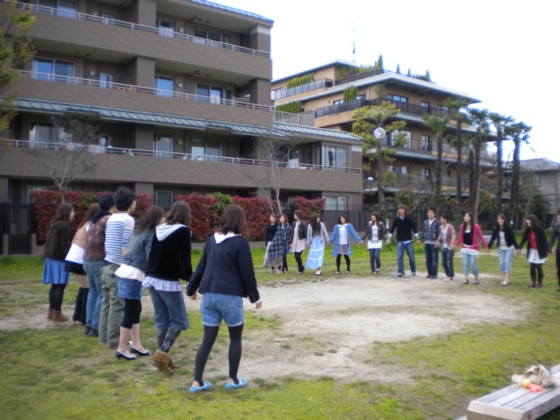(Sin intención de ofender por mi parte) Cuando el general MacArthur equiparó a los japoneses con niños de 12 años, probablemente se fijó en estampas como la que aquí muestro: un grupo de estudiantes universitarios de primero y segundo año se dividen en dos subgrupos y comienzan el conocido juego floral infantil –por lo general, de guarderías- del 花一匁 (Hana-ichi-monme). Cantando al unísono cosas como あの子が欲しい (ano-ko-ga-hoshii) y 決まった (kimatta), eligen a una persona del equipo contrario. Los dos contrincantes se la juegan al じゃんけん (Janken, el equivalente al piedra, papel o tijera), y el grupo ganador se regocija con su campeón infantil. Por supuesto, no toda la vida de los jóvenes japoneses se reduce a juegos de guardería, pero sí es cierto que cuando se reúnen en un grupo numeroso, se produce un curioso –al menos para un no japonés- proceso de infantilización comunitaria.
When being by themselves, the Japanese can be extremely mature and responsible, especially in matters related to family and work, but when it comes to informal groups and leisure, there seems to be a “Back to kindergarten” appeal. The reasons might be: the celebration of innocence and the desire of looking fresh and young, the showing of themselves as something not threatening –and therefore やさしい yasashii- and so on.
But what this group of youngsters probably don’t know is the real origin of the here shown 花一匁 game. In ancient Japan, when poor families with many children didn’t have enough income to feed them all, they sold one or more of their most beautiful daughters as in an auction. Then, in the game, here comes the buyer’s song 勝ってうれしい花一匁 katte-ureshii-hana-monme, I’m happy because I won and purchased the flower.
日本人の大学生は実際は大人であるが遊びで大勢が集まるたびに子供っぽいゲームをするのが大好きです。先日、京都の鴨川の河川敷で20人ほどの若者は2組に分かれ、花一匁という幼稚園のゲームを嬉しそうにし始めました。彼ら全員がこのゲームの起源を知っている可能性は低いだろう。昔の日本では子供が多い貧乏な両親が花一匁を売る代わりに一番美しい娘を競売にかけました。ゲームで「あの子が欲しい」というかけあいの後で、最後に、買手さんは「勝ってうれしい花一匁」と言うのです。

